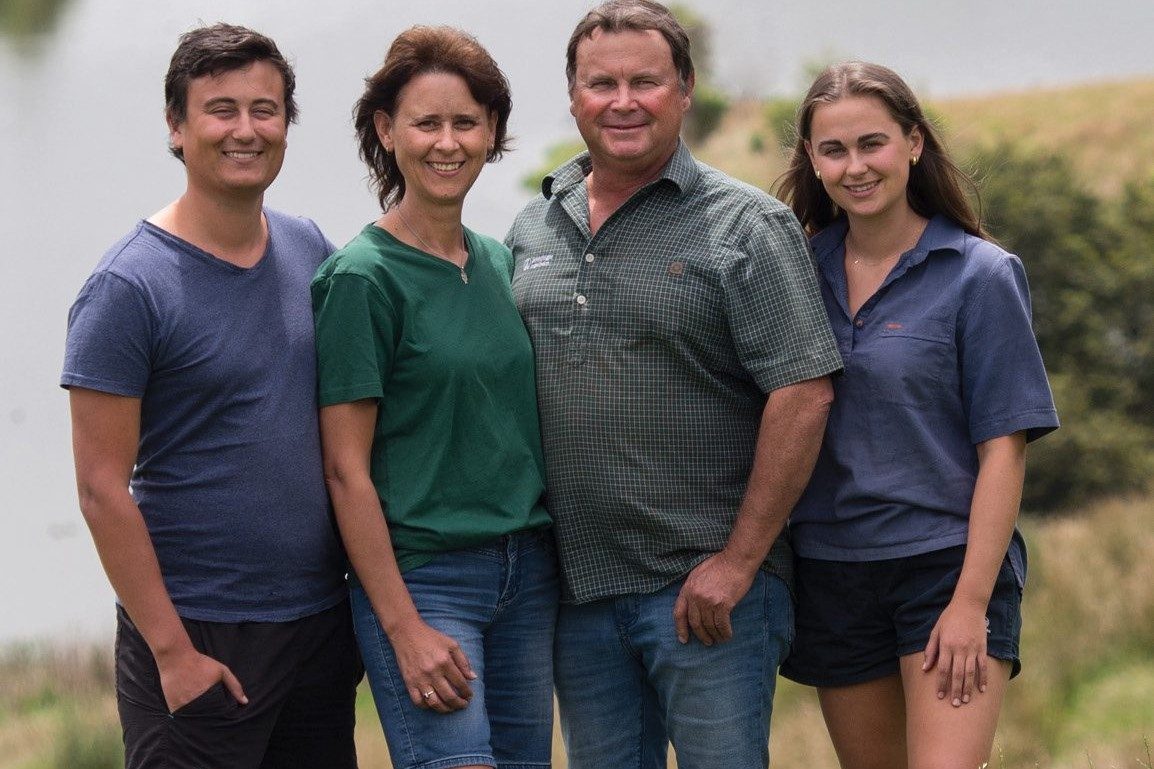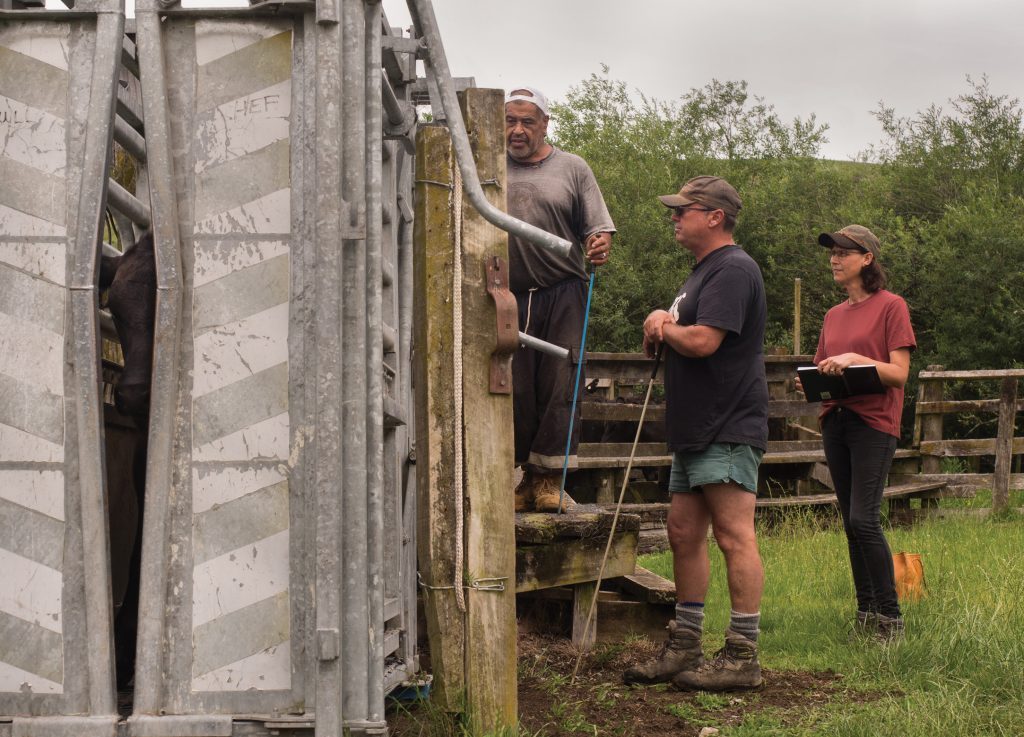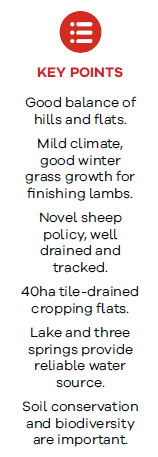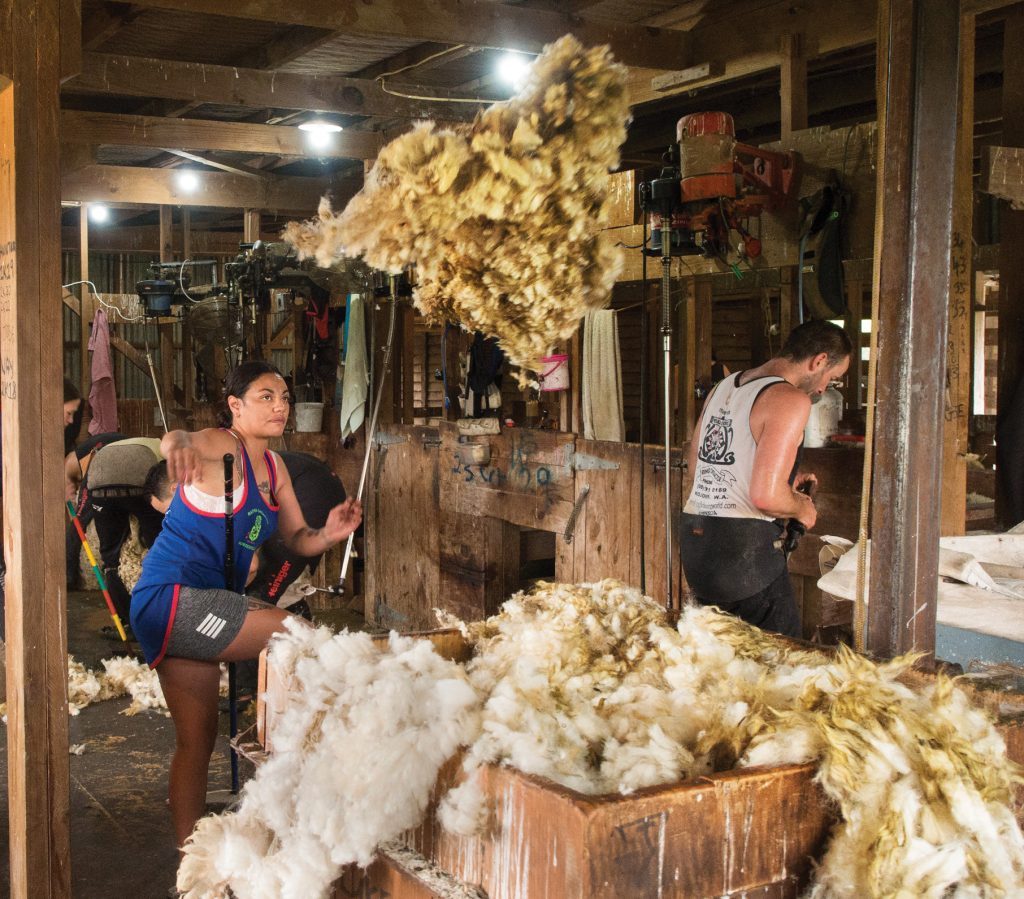Hard work builds success
Rob and Marie Burke have done the hard yards at Puketira Station and are still looking for ways to increase revenue and improve practice.
Story and photos by Louise Savage.

Rob and Marie Burke’s successful partnership is the result of 30 years of hard work, adaptability and resilience. The couple has reached the stage where they have consolidated their land holdings, have a plan to take them forward, succession planning well underway, manageable debt and an “empty nest”. The Burkes believe their most valuable assets to be “ourselves” and therefore aim to farm smarter, not harder. They have constantly adapted over the years and aim to inspire the next generation of potential farmers.
The Burkes farm picturesque Puketira Station at Ormond, Gisborne, where Rob grew up and is the third generation owner to farm there. Marie grew up only 25km away as the crow flies, on Mangakino Station, Te Karaka.
The 354ha station home block comprises 302ha hill country, divided into 19 paddocks farmed for sheep and beef, 40ha of tile-drained flat land used for cropping followed by winter feed crops, and 12ha cut for haylage The hill country is 60% rolling, 25% easy and 15% steep.

In addition, 23ha of neighbouring flat land is leased from family and they recently bought 15ha from a neighbour.
Being relatively close to the coast, winters are mild with good grass growth for finishing lambs. The station receives 1192mm rainfall a year.
Rob and Marie work full time on the farm and are assisted by long-standing full-time employee Mark (Hek) Kingi, with casual staff Alan Nicholl and Neal Ingram as needed in peak times. Jess and Matatua Ruru and family assist with docking, crutching and calf marking. The Burkes encourage school and university students, offering holiday work and experience whenever possible, and Marie works about 15 hours a week for interactive primary-school programme Farmer Time. They feel this is important to foster interest in agriculture among future generations.
Stock on Puketira comprise 112 mixed-age cows, 101 calves, 29 R3 heifers, 5 bulls, 2200 lambs and 130 tail-end ewes. Numbers are low at this time, as the Burke’s policy is to farm for a drought. They will buy 2000 to 2500 more lambs in the next two to three months, then up to 1300 in-lamb ewes.

Adapt and diversify
Rob drew on his 19 years of cropping experience, leasing additional land to increase their cropping area to 250ha to cover their mortgage repayments. At peak times they ran 24-hour shifts. They grew early maize, sweetcorn, popcorn and seed maize, while farming sheep and cattle on Puketira. Marie ran the office side of the business, continued to teach, helped on the farm after work and on weekends, and managed the seasonal jobs such as docking. To say they were busy was an understatement. The workload took its toll on them both.
In 2005, only a year after buying Puketira, leased cropping land on the Waipaoa River flats was inundated twice and the entire maize crop lost. In 2007 they made the decision to sell 14ha of their land at Te Karaka to relieve them of some debt.
Ten years of concerted farm and business development followed, including fencing, tracking and drainage. More than 30ha of formerly untillable wet flats were made suitable for high-producing crops. But while the farm was very productive, every dollar had been reinvested into the farm and no principal had yet been repaid to the bank.

Sheep on Puketira
The Burkes are able to fatten lambs in winter, thanks to the normally benign Gisborne climate and their large area of flat land, grassed after the summer crops are harvested.
Each year, between July and September, the Burkes buy 1250 to 1300 ewes in-lamb with multiples, including triplets, sourced from anywhere they’re available in the North Island. They are put out in mobs according to paddock sizes.
Marie says, “Our sheep breeds are a mixed bag as it depends on what ewes we buy and what they’ve been mated to. We can have all sorts, and lambing dates within each mob span a wide range of dates because the ewes might have come from two or three different farms.”
Puketira docks 170% on average. That varies depending on what ewes were bought. Weaning is the first week of January, with 200-300 lambs picked off the ewes and sent to be killed, while the rest are farmed on into the winter finishing programme. Those are ready for slaughter from May to mid-October.
“We weigh all lambs”, Rob says. “We’re aiming for 50 to 52kg liveweight to the works.”
Marie says the lambs are sold on schedule to whichever company consistently offers the best prices and most recently that’s been Davmet in Hawke’s Bay.
“We don’t know where lambs will go this year. It depends on when the road to Hawke’s Bay gets re-opened,” she says.
All long-wool ewes are shorn in early December to be ready for sale early January.
“We used to shear all winter lambs at 43 to 47kg, but the cost is so high and the return so low we don’t shear them at all. If needed, the lambs will get a full belly and a crutch, but we prefer not to.”
Puketira has a Hecton sheep handler with a handpiece set-up enabling them to do most of their own dagging.

Cattle
Angus cows are used as a pasture-grooming tool to create the best possible feed for lambs and young cattle on Puketira. There are about 140 breeding cattle, including the R3 heifers, a reduction from a one-time high of 190, which proved to be too many.
Mid- to late-winter is when the stocking rate is highest on Puketira. Cows are mostly set-stocked to clean up paddocks, and are fed supplementary haylage in June and July. Weaners get lucerne haylage in August and September. All supplementary feed is made on the farm.
“We farm for a summer drought,” Marie says. “So with low stock numbers during summer, the cows help keep on top of grass and weed growth. With the wet summer we’ve just had, they have feed coming out of their ears.”
Angus bulls go out into the cow and heifer mob on October 25 until December 27. They get moved into calving paddocks in late July and calves start to arrive on August 1, “Just as our spring feed starts lifting.”
Between 30 and 35 replacement heifers are retained with cows culled on condition rather than age. The remaining progeny are sold store, mostly by private sale or occasionally at the Matawhero sale yards. Steers and the tail-end heifers are taken through one winter and sold in spring between 12 and 18 months of age.
Cropping and pasture
The Puketira flats are planted with a summer crop commencing October 1. Cedenco leases them for sweetcorn. In autumn, after harvest, Rob re-sows with H1 Italian ryegrass with a small amount of brassica in the mix, using the station’s own cultivation and sowing gear.
Soil fertility testing is done annually and the farm receives 250–280kg/ha superphosphate, with a small amount of urea (100kg/ha) used on the new grass.
Hay paddocks are usually shut up on October 1 for one or two cuts, and 3.5ha of lucerne provides four or five cuts.
Animal health plan
Upon arrival, all sheep are given a broad spectrum worm dose and quarantined. They are treated with flystrike protection if indicated.
At docking, from September to November, lambs get Coglavax vaccine and Clik Extra fly treatment, ram lambs are castrated and ewes drenched and dagged. Lambs receive another Coglavax, a drench and Clik Extra at weaning in January. Winter lambs are then drenched on a 28-day programme.
Cows and R3 heifers are pregnancy-tested in April; the wets receiving copper, a pour-on (Abamectin) and 7-in1 vaccine. Cull cows go to AFFCO and Greenlea.
In April, weaned calves get 7-in-1 vaccine and Eclipse pour-on, followed six weeks later by a second vaccine and copper. Young cattle are subsequently dosed at approximately three-monthly intervals. The R2 replacement heifers also get a 7-in-1 lepto boost.
In May, bulls are vet tested and have a BVD vaccine followed by a lepto boost in July.
Before calving, the cows are given a liver-fluke drench, copper and those over five years get a magnesium bolus.
Other land bought
Since 2016 the Burkes have bought and sold different blocks of land and in turn Puketira has become freehold – a huge achievement.
In 2016, with the intensive phase of development on Puketira completed, a new development block was bought at nearby Bond Road comprising an 8ha vineyard, subsequently converted to cropping land, the five-bedroom house renovated and rented out. This block provided work for staff at quiet times of the year.
The Bond Road block consolidated the business closer to home, and in 2017 the remaining flat land at Te Karaka was sold to relieve the very high workload, the stress, and above all, bank debt. Puketira was at last freehold from the bank, a huge achievement.
By 2017, falling revenue from maize and sweetcorn meant it was no longer viable for smaller operators to grow it. The decision was made to lease out the flats at both Puketira and Bond Road and in November 2020 the latter was sold.
The Burkes have subsequently leased the next-door “airstrip block” of flats from Rob’s uncle, Tim, and have bought a 15ha hill block adjacent to Puketira from neighbours.
The Burkes concede their first decade of farm ownership was stressful and both physically and mentally exhausting. Years later, Marie was to draw on her experience when she and Sandra Matthews started Farming Women Tairawhiti, to connect and support rural and farming women.
“We’ve learnt a lot from past experiences. We like to reflect on the choices we’ve made, whether they’ve been good ones or not, and always try to improve on what we do,” Marie says.
“Having seen so many ups and downs of weather and outside factors affecting farming, we know now that when things are tough they eventually get better. High debt was an obstacle early on in our farming life. We got on top of that by buying, improving, and selling smaller properties.”
Rob adds, “Not every year will be a good one, and often when one part of the business is having a good year, another part won’t be. That’s just farming. We’ve been in business long enough to realise it’s better to look at 10-year averages rather than each year in isolation.”
The biggest challenges in recent years included the Covid lockdowns, when stock still needed the same amount of care as usual, but no staff could come on farm to help.
Daughter Jess and partner Brad filled the staffing gap during the first lockdown, but had to isolate for 10 days first.
“Then special dispensation from MPI was needed to get the shearers in, and every surface of the woolshed and yards had to be cleaned down. Not easy,” Rob says.
Other major challenges include the volume and speed of changes to Government policy, regulation and consultation, which Marie says have been exhausting and have caused costs to rise faster than earning capacity.
Now fences and tracks require reinstating following Cyclone Gabrielle. Son Mat has been home to help with the clean-up.
“For the next five years we want to increase productivity and efficiency, continue to work on soil conservation planting and native planting. I like to plant fruit trees along the laneways to increase food for bees and for us,” Marie says.
Farm succession
Rob and Marie began succession discussions early with their children when Mat (28) and Jess (23) were in their teens. At this stage neither of their children intend to farm, but Rob and Marie wish to help other young people who do and have looked at ways to incorporate a new generation into their business plan.
Marie sees future potential in equity partnerships to bring young farmers into the sheep and beef industry and achieve a stake in farm ownership, similar to what’s been done in the dairy industry.
With an eye to the future, the farm was subdivided into three blocks a few years ago, and the Burkes have just put one block on the market.
“If it doesn’t sell, we may look at employing a stock manager in the future.”
Marie and Rob are always on the lookout for new possibilities. Not being afraid to seize opportunities has enabled them to get to where they are today.
Rob says he wants to go fishing more in the future. As a result of the Bond Road sale, the family has a holiday house now, so spending time there is a dream they both have.
The history of Puketira
Puketira Station is part of the original Meadowbank Station, bought in 1938 by Rob’s great grandfather and has come down through the generations. The station was divided in two in 1970 and Rob’s parents Patrick and Christine bought Puketira, which was very underdeveloped, having large paddocks, considerable areas of scrub and rushes, and no house, yards or woolshed.
Patrick and Christine built a house, developed the farm, drained the flats, planted trees, created dams and tracks and raised their family throughout the 1980s and some of the toughest times of farming.
When Marie and Rob married in 1993, they bought their first block of flat land – 8.9ha at Te Karaka. A few years later they added a neighbouring 26.3ha on which they cropped and fattened lambs in their spare time.
In 2004, Rob and Marie bought the land, stock and machinery at market value and Rob’s parents re-invested in the farm at an agreed interest rate to give themselves an income to retire on.
Some professional advisers warned them that the farm was too small and the debt loading too high, but Rob and Marie decided to back themselves and surrounded themselves with a team to make it work.




